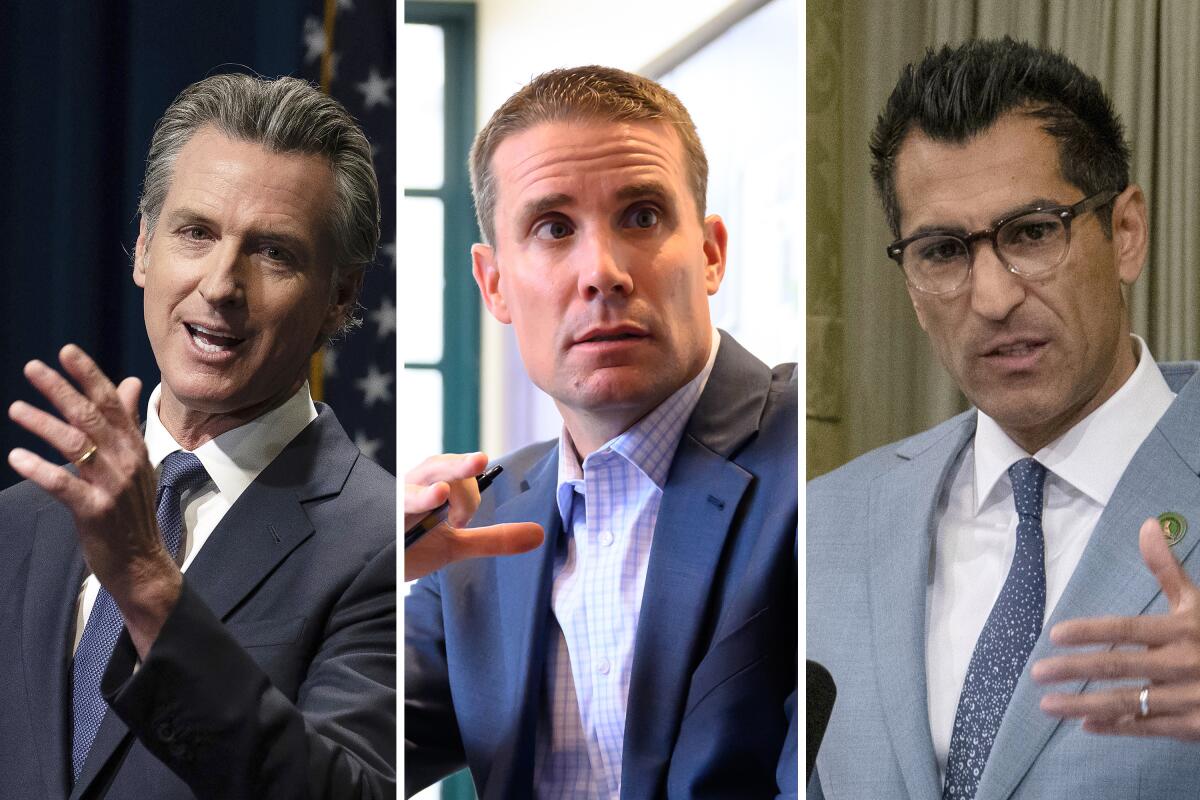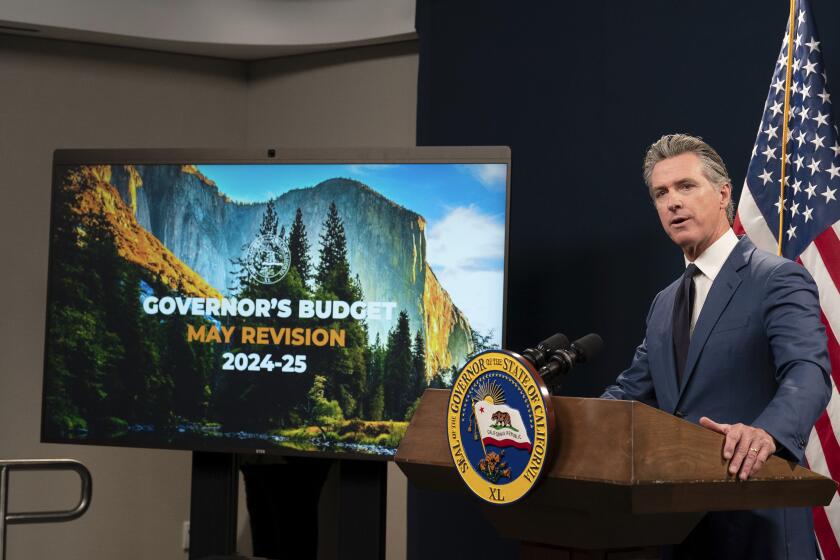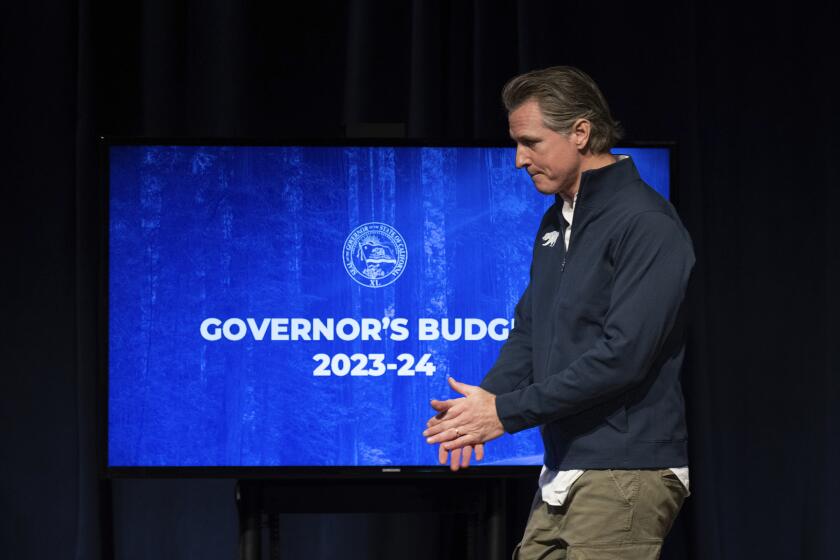With deadline nearing, Newsom and lawmakers disagree over solutions to California budget crisis

- Share via
SACRAMENTO — With a deadline looming, Gov. Gavin Newsom and Democrats in the state Legislature are working to settle their differences over access to public healthcare services, delaying minimum wage increases for workers and pausing tax credits for businesses as they cut their way out of California’s $45-billion budget deficit.
The governor’s proposal takes $12.2 billion from the state’s rainy day reserves to help cover the shortfall over the next two years and reduces funding to address climate change, provide broadband internet and increase subsidized child care, among dozens of other cuts.
Lawmakers responded last week with their own plan, which largely aligns with the governor’s strategy but pushes back on some of his proposals to reduce funding for homelessness and housing. Democrats in the Legislature called for substantially deeper cuts to climate change programs and the state prison system.
Assembly Budget Chair Jesse Gabriel (D-Encino) said the Legislature’s budget pitch restores “many of the most painful cuts to safety net programs, housing and health, including rate increases for health providers” proposed by the governor. Lawmakers have targeted some of Newsom’s marquee programs, such as decreasing grants to curtail homeless encampments and money to support behavioral health.
“These were difficult choices,” Gabriel said in an Assembly budget hearing last week. “But we had to set priorities and create a plan of action because that is what this moment requires.”
California is experiencing a deficit largely because tax revenues came in lower than expected, which Newsom has described as a return to normal after the economic boom brought on by the COVID-19 pandemic and billions of dollars in federal stimulus payments and business loans. Overspending, due to poor revenue forecasts, has also worsened the state’s financial troubles.
Staff members for legislative leaders and the governor have negotiated privately for the last week in hopes of reaching an agreement before the June 15 deadline for the Legislature to pass a state budget.
If lawmakers and the governor fail to reach a budget deal in the coming days, the Senate and Assembly are expected to pass a preliminary budget next week. Lawmakers will then adopt additional bills that reflect an agreement with the governor before the budget takes effect on July 1.
These are a few key differences they are expected to resolve in a final budget agreement:
Medi-Cal reimbursement rate increases
Newsom and lawmakers renewed a tax last June on managed care organizations, known as the MCO tax. The tax applies to health insurance providers that charge fixed monthly payments for services and is based on the number of people enrolled in plans each month.
The tax essentially acts as a mechanism to allow California to collect billions in additional federal funds for Medi-Cal, California’s healthcare system for low-income residents, as Democrats expand eligibility to all income-qualifying immigrants.
The law Democrats approved last year extends the MCO tax through 2027 and dedicates a portion of the revenue to increase payment rates to doctors and other Medi-Cal providers, in some cases, for the first time in two decades.
But Newsom’s budget proposal repurposes the funding, taking $6.7 billion over multiple years that was intended to go toward higher provider rates and using that money instead for general Medi-Cal costs. By tweaking the tax, Newsom’s changes could generate $9.7 billion to support the Medi-Cal program in total, with federal approval.
The governor’s proposal frustrates doctors and other healthcare providers, who have argued for years that the state’s reimbursement rates for serving Medi-Cal patients are too low to sustain a practice. The low reimbursements rates, they say, leave the state system short of providers and California’s most vulnerable populations without access to care. Doctors are leading the charge to pass a measure on the 2024 ballot that would permanently establish an MCO tax and direct a portion of the revenue to higher provider reimbursement rates.
The budget plan offered by Legislative Democrats rejects Newsom’s plan to eliminate more than $2.4 billion in provider rate increases scheduled to take effect Jan. 1, 2025. Lawmakers instead delay most of the rate hikes until 2026.
The California Medical Assn., which is among a coalition opposed to both proposals, said the governor and lawmakers “have a generational opportunity to achieve true equity in health care.”
“Too many families cannot get the care they need because we have refused to appropriately fund Medi-Cal,” said Dustin Corcoran, chief executive of the CMA. “The state has added millions of new patients in Medi-Cal and this funding would ensure we will have the providers to care for them.”
In his revised budget proposal, Gov. Gavin Newsom lays out his plan to shrink California’s yawning deficit. Here’s what’s in it.
Increase minimum wage for healthcare workers — or not
Newsom signed legislation in October that increased the minimum wage for healthcare workers to $25 per hour. Labor unions celebrated their hard-fought wage hike, which will mostly benefit workers who are not directly involved in providing care.
At the time, no one, including the governor, publicly mentioned a major caveat he laid out behind closed doors before he agreed to sign the bill: If state revenues ended up as dire as forecasts predicted, there was “no way in hell” he would allow the law to take effect as planned in June.
Within weeks after signing the law, Newsom began calling for reforms to reduce funding for the wage increase as the budget deficit grew. Negotiations, between the administration, labor unions, and the healthcare industry, have played out privately for months without a resolution.
The governor since has been crystal clear about his concerns over the plan’s price tag, originally pegged at $2 billion from the state general fund, with another $2 billion paid with federal funds, in its first year. Other estimates suggest the administration is overestimating the cost, which could be closer to $300 million.
With negotiations with labor ongoing, Newsom provided no funding for the wage increases in his May budget proposal. Democratic lawmakers, siding with unions, want to spend $100 million for the pay raises in 2024-25, which would increase to $300 million in the third year of implementation.
Gov. Gavin Newsom said his staff has been working with Democrats in the Legislature on the state’s healthcare minimum wage law in light of budget concerns.
How hard to hit business
In the early stages of the pandemic, Newsom and lawmakers paused the ability of businesses with income of more than $1 million from deducting net operating losses from their tax bills, and limited business tax credits in the state to $5 million per filer in 2020, 2021 and 2022.
The changes were adopted to temporarily boost state tax revenues during a chaotic time when the pandemic created economic uncertainty across the nation and California projected massive revenue losses.
Newsom restored the deductions and ended the tax limits one year early in 2022 when the state anticipated a massive budget surplus. Now with California facing a deficit, he wants to suspend and cap the tax breaks again for the 2025, 2026 and 2027 tax years, with the ability to restore the credits if revenues turnaround.
Lawmakers agreed with the governor’s plan, but sought to apply the changes one year earlier. Implementing the tax credit adjustments in 2024 allows the Legislature to adopt fewer cuts to other programs in its budget plan, saving more than $3 billion into 2026.
Loren Kaye, president of a think tank affiliated with the California Chamber of Commerce called the California Foundation for Commerce and Education, said that companies factor the credits into their future business plans and that abruptly losing those savings can force them to scale back on employees or inventory to cover the cost of an unexpected tax bill.
“In this case, the Legislature has made it a little bit worse because at least with the governor’s proposal you have a heads up because it begins in tax year 2025,” Kaye said.
The limit marks the second time in five years that the state has capped tax credits, which could serve as a disincentive to companies that operate in California because of generous research and development or motion picture credits, Kaye said.
“We’re all about innovation,” Kaye said. “It’s one of our great competitive advantages and it could be heartbreaking to see people think that we’re not supporting innovation the way we have historically.”
Democratic lawmakers and Gov. Gavin Newsom are scrambling to lessen California’s budget deficit, which Newsom estimated at $37.9 billion in January.
Taking shots at Newsom’s projects
The Legislature’s proposal highlights key differences between the governor and lawmakers in his own party over funding for some of his marquee policies, including homelessness and prison reform.
Lawmakers proposed an additional $1 billion in cuts to the Department of Corrections and Rehabilitation, which includes at least $12 million in reductions to the governor’s project to transform San Quentin. Newsom’s cuts included $80.6 million in savings from the newly announced deactivation of 46 housing units at 13 state prisons.
Democrats in the Legislature also want to spend $1 billion more than the governor on a sixth round of Homeless Housing, Assistance and Prevention grants to local governments to combat the homelessness crisis. At the same time, lawmakers proposed cutting $100 million in funding to clean up homeless encampments in the current budget year.
More to Read
Sign up for Essential California
The most important California stories and recommendations in your inbox every morning.
You may occasionally receive promotional content from the Los Angeles Times.














